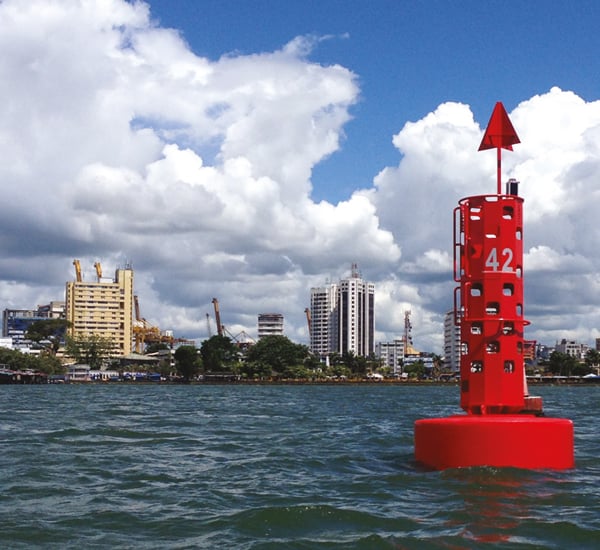
Client: Dirección General Marítima Autoridad Marítima Colombiana
Partner: Iner Consultores, S.A.
Project scope: Marine lanterns and remote monitoring system to equip:
• 49 Lateral Buoys
• 2 Safe Water Buoys
• 11 Cardinal Buoys
• 23 Danger Buoys
• Additional Beacons
Challenge:
• Replace outdated and ineffcient marine lanterns
• Reduce maintenance costs for Aids to Navigation
• Reduce reliance on visual inspection and proactively address potential points of failure
• Adopt a centralized monitoring system that could be deployed across a wide territory, including regions
without GSM coverage
Product selected: Carmanah M860 Marine Lantern with Satellite Monitoring
Benefits:
• Fully self-contained, low maintenance hardware
• Remote diagnostics including lantern health reports & data trending
• GPS location reporting for all AtoNs
• Scalable, reliable monitoring solution suitable for
implementation in all areas of DIMAR’s territory
BACKGROUND
Dirección General Marítima Autoridad Marítima Colombiana (DIMAR) manages maritime activities over 928,660 km² of Colombia’s coastal and inland waterways. With a growing import/export market in Colombia, DIMAR was under pressure to improve safe navigation by replacing outdated marine lanterns and buoyage systems. At the same time, DIMAR was looking to introduce a solution that could help them better manage these critical assets by monitoring them from a centralized location. While DIMAR had implemented a monitoring solution in the past, they faced several challenges. Traditional GSM-based solutions did not offer reliable coverage in all regions of DIMAR’s large territory. Further, the modular design and high power draw of these systems required additional solar panels and external connectors that left the systems more vulnerable to maintenance issues. DIMAR required a solution that could help them simplify asset management and reduce costly maintenance trips.
SOLUTION
In the fall of 2013, DIMAR piloted the M860 Monitoring Service at two of Colombia’s busiest ports: Cartagena and Buenaventura. With onboard satellite-based monitoring capabilities and proven, energy efficient IALA compliant LED optics, the M860 lantern provided a reliable, low-maintenance and cost-effective solution to address all of DIMAR’s challenges.
Lantern and monitoring hardware in one selfcontained design
Introduced in the summer of 2013, the Carmanah M860 base model combines best-in-class, high-effiency solar panels and premium components to achieve one of the lightest-weight, most compact lanterns available in its class. The DIMAR M860 lanterns also included an integrated chipset that enabled the lanterns to communicate directly with a wide-coverage satellite network. DIMAR was able to rely on a single hardware unit to achieve both IALA compliant signaling and a data service that could transmit essential health and geo-location information back to a dedicated secure web service. By combining these two critical systems into a single lightweight hardware unit, DIMAR was able to benet from faster, simpler installation without external connectors for fewer points of failure.
Status reporting and critical alerts
Special consideration was given to providing DIMAR with secure web-based tools to trend lantern performance, conduct remote diagnostics and detect when an AToN had moved out of position. Carmanah developed an online reporting tool suitable for multiple users. The system provides information on battery state-of-charge, temperature conditions, battery voltages and “on/off” status for each individual lantern. In addition, the web interface noties the user when a lantern has entered Carmanah’s Automatic Light Control (ALC) mode. This optional ALC feature recognizes trends in battery charging and adjusts light intensities under persistently poor weather conditions to prevent the battery from reaching a critical state. When combined with performance trending, ALC status is a key value to help detect potential problems before a failure occurs - a powerful feature to help ensure safe navigation and to effectively manage maintenance schedules. As a nal precaution, the Carmanah system also transmits email alerts in cases where a critical anomaly has been detected; including notifying specied users when a lantern is not functioning or is out of position.
Data security and reliability
One of the most critical aspects for DIMAR was to be able to achieve dependable data transmission in areas well beyond the reach of reliable cellular coverage. Carmanah chose to integrate the M860 to a satellite platform to provide superior communication reliability. The platform uses a direct sequence spread spectrum, a redundant chipping code that helps resist interference, and multiple transmissions (3 times per packet) to increase reliability.
Advanced energy management
To ensure that DIMAR did not have to compromise on their autonomy or range requirements, the M860 included several key energy management features. The Carmanah Monitoring Service uses a highly ecient, low-power chipset to minimize load on the battery. The Carmanah M860 also uses Maximum Power Point Tracking to automatically adjust charge voltages with temperature changes. By maintaining ideal temperatures and charge conditions under varying weather conditions, this feature prevents battery damage and allows the system to extract full value from the available solar energy, even under cloudy or shady conditions. DIMAR was able to benet from Carmanah’s extensive background in solar energy management to achieve the full performance they required within a product designed to last without battery replacement for years into the future.
RESULTS
With access to the Carmanah M860 and support from regional distributor Iner Consultores working in conjunction with buoy manufacturer Almarin Equipos y Servicios Portuarios S.L, DIMAR beneted from a robust solution to replace their outdated marine lantern technology. With the addition of monitoring capabilities, DIMAR was able to achieve a low-maintenance, state-of-the-art system suitable for ensuring safe-navigation at two of Latin America’s leading ports.

